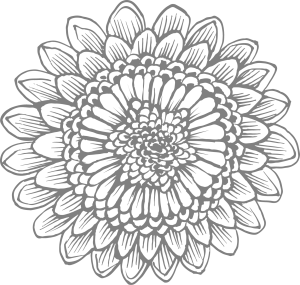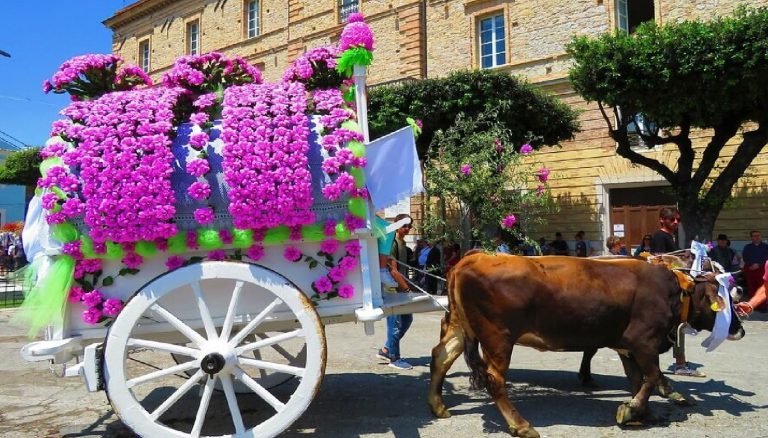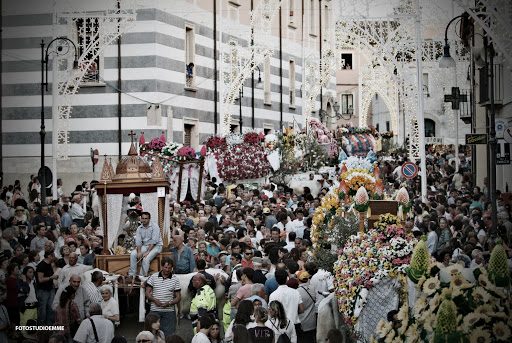LARINO
The feast of the patron saint St. Pardo takes place on 25, 26 and 27 May, with the addition of the blessing of the animals on 24 May (for the past few years) followed by a shorter procession.
On 25 May, the statues of the village saints are taken to the cathedral to ‘keep St. Pardo company’. The removal of the icon of St. Primian is carried out by a fairly small group of people and wagons (only the first ten) which are welcomed in the small square in front of the cemetery by torchlight, while the small procession goes to pick up, in a very intimate and participatory ceremony, the statue of St. Primian which is then placed in wagon No. 1 to be taken back to the Cathedral. . The procession is accompanied by lights, torches, the singing of the Hymn of St. Primian and the Laudata di San Pardo as well as the continuous ringing of the Cathedral bells and the sound of cowbells hanging from the necks of the cattle. The parish priest of the cathedral waits for the carts in front of the churchyard and announces them one by one amidst the ringing of the cathedral bells and the cowbells of the cattle in procession.
On 26 May, the arrival of the relics in the town is commemorated and St. Pardo is proclaimed the main patron saint of Larino. On this day there is a parade of all the male saints through the streets of the town. This is a sort of procession of all the Saints: only on special occasions are all the icons brought out, even the female ones (jubilee years, for example). Traditional blankets and banners depicting St. Pardo can be seen from the balconies of the old town centre, waving in devotion as they pass by. In addition, rose petals are sometimes thrown on the bust and urn containing the Saint’s relics as the patron saint passes by. The sound regime of the festival on this day is enriched by the presence of the band that accompanies the processional procession.
The 27th of May coincides with the final stage of the festivity, which consists of returning the Statue of St. Primian to its usual home, starting from the historical centre. Once the co-patron has been returned to his chapel and left “in the company” of the patron saint, St. Pardo, the families make a stop during which an open-air meal is consumed, which everyone calls “scampagnata” (picnic), characterised by great conviviality, an abundance of food and drink, songs and an atmosphere of great enthusiasm. After the stop, the icon of St. Pardo is placed back on float No. 1 and the processional procession leaves for the old town centre, to take the bust of St. Pardo back to the centre where it will ‘accompany’ all the saints back to their churches and then ‘re-enter’ the Cathedral in the midst of a large crowd gathered in the church and on the parvis to admire and welcome it.
In the oral tradition, the processional system that takes place in Larino is called ‘Carrese’, a term that refers to the ancient practice of racing carts that decided the order in which they would then parade on the day of the feast, carrying in procession the icon of the patron saint and the co-patron saints (according to forms found today in cart races in Lower Molise). The “Carrese” is also a monodic song, also called “Laudata” or “Carrera”: a song of deep theological significance dedicated to God, the Madonna, Saint Pardo, the co-patron saints Primiano, Firmiano and Casto and other saints venerated in Lower Molise.
The floats that parade can be pulled by oxen, calves or sheep, or be very small, dragged by hand by children, but still have the progressive number of the float officially participating in the Carrese. The header of the cart is usually a family one (uninominal carts), but sometimes it can also be a company of two or more people, whether relatives or friends (plurinominal carts).
There are two types of floats: the traditional floats, also known as ‘dome’ floats, as they have a typical dome covered with a uniform layer of flowers and three ‘craste’ (vases) arranged in sequence on top. There are two types of floats: the traditional floats, also known as ‘dome’ floats, as they have a typical dome covered with a uniform layer of flowers and three ‘craste’ (vases) arranged in sequence on top. On the 26th and 27th of May, an olive branch is placed on this type of float, from which scamorze passite are hung, a symbol of what has always supported the town economically: agriculture, especially olive growing, and sheep and cattle breeding, which are also considered an auspicious sign for the harvest and the year that opens with the renovatio represented by the festival. The second type is that of the ‘triumphal floats’ with arches, columns and geometric domes of varying sizes made of worked wood and assembled, according to the creativity of the author, with the intention of depicting Gothic or Romanesque churches, decorated with embroidered curtains and a number of small bulbs for a small quantity of flowers.
Each float is decorated and the key elements are the paper flowers, which involve a long process that is handed down from year to year, from generation to generation.
Animals play a crucial role in the ceremonial, in a form that the community defines as cooperation (‘animals help us celebrate our Saint’). These animals are respected and honoured as an integral part of the sacred ceremonial and the care that goes into their preparation in the preceding months is a sign of special attention to their welfare and the building of a relationship of understanding and mutual comprehension with those who will handle them. This activity, which often starts in March and lasts up to 8 weeks, is called “la doma” and involves a series of walks along peri-urban areas, preferably with small slopes and changes in level, to allow the animals to “take a breath” (i.e. train themselves to walk for a long time) and above all to learn to be docile and balanced with those who will handle them in the procession.
A remarkable feature of the ceremonial is the articulated sound space that accompanies the entire festive cycle in its various articulations. First and foremost is the singing of the traditional Laudata. The second is linked to the shooting and fireworks on the 26th of May. The third is the ‘bell ringing’, i.e. all the sounds made both by the cowbells hung around the necks of the cattle during the processions, and by the bells of the Cathedral, which ring almost continuously during long phases of the processional recourse on the 26th and during the various returns to the Cathedral of the processions on the 25th and 27th.
The festive practice is maintained and passed on from generation to generation through an intense interweaving of informal learning and ‘learning by doing’.
An important set of modes of knowledge transmission relates to the traditional singing of the laudata: a mode of monodic singing now practised by very few (although growing slightly in recent years, not always with sufficiently careful philological rigour) which is taught by a few, rare masters recognised by the local population as holders of this knowledge by having a few young people and children accompany them along the processional route, even showing them postures, intonations, durations of sound holding that are considered typical and correct for this mode of singing, which is also, in its own way, competitive in terms of note holding, power of emission and purity of sound.

VIDEO
IMAGE GALLERY


LARINO
The feast of the patron saint St. Pardo takes place on 25, 26 and 27 May, with the addition of the blessing of the animals on 24 May (for the past few years) followed by a shorter procession.
On 25 May, the statues of the village saints are taken to the cathedral to ‘keep St. Pardo company’. The removal of the icon of St. Primian is carried out by a fairly small group of people and wagons (only the first ten) which are welcomed in the small square in front of the cemetery by torchlight, while the small procession goes to pick up, in a very intimate and participatory ceremony, the statue of St. Primian which is then placed in wagon No. 1 to be taken back to the Cathedral. . The procession is accompanied by lights, torches, the singing of the Hymn of St. Primian and the Laudata di San Pardo as well as the continuous ringing of the Cathedral bells and the sound of cowbells hanging from the necks of the cattle. The parish priest of the cathedral waits for the carts in front of the churchyard and announces them one by one amidst the ringing of the cathedral bells and the cowbells of the cattle in procession.
On 26 May, the arrival of the relics in the town is commemorated and St. Pardo is proclaimed the main patron saint of Larino. On this day there is a parade of all the male saints through the streets of the town. This is a sort of procession of all the Saints: only on special occasions are all the icons brought out, even the female ones (jubilee years, for example). Traditional blankets and banners depicting St. Pardo can be seen from the balconies of the old town centre, waving in devotion as they pass by. In addition, rose petals are sometimes thrown on the bust and urn containing the Saint’s relics as the patron saint passes by. The sound regime of the festival on this day is enriched by the presence of the band that accompanies the processional procession.
The 27th of May coincides with the final stage of the festivity, which consists of returning the Statue of St. Primian to its usual home, starting from the historical centre. Once the co-patron has been returned to his chapel and left “in the company” of the patron saint, St. Pardo, the families make a stop during which an open-air meal is consumed, which everyone calls “scampagnata” (picnic), characterised by great conviviality, an abundance of food and drink, songs and an atmosphere of great enthusiasm. After the stop, the icon of St. Pardo is placed back on float No. 1 and the processional procession leaves for the old town centre, to take the bust of St. Pardo back to the centre where it will ‘accompany’ all the saints back to their churches and then ‘re-enter’ the Cathedral in the midst of a large crowd gathered in the church and on the parvis to admire and welcome it.
In the oral tradition, the processional system that takes place in Larino is called ‘Carrese’, a term that refers to the ancient practice of racing carts that decided the order in which they would then parade on the day of the feast, carrying in procession the icon of the patron saint and the co-patron saints (according to forms found today in cart races in Lower Molise). The “Carrese” is also a monodic song, also called “Laudata” or “Carrera”: a song of deep theological significance dedicated to God, the Madonna, Saint Pardo, the co-patron saints Primiano, Firmiano and Casto and other saints venerated in Lower Molise.
The floats that parade can be pulled by oxen, calves or sheep, or be very small, dragged by hand by children, but still have the progressive number of the float officially participating in the Carrese. The header of the cart is usually a family one (uninominal carts), but sometimes it can also be a company of two or more people, whether relatives or friends (plurinominal carts).
There are two types of floats: the traditional floats, also known as ‘dome’ floats, as they have a typical dome covered with a uniform layer of flowers and three ‘craste’ (vases) arranged in sequence on top. There are two types of floats: the traditional floats, also known as ‘dome’ floats, as they have a typical dome covered with a uniform layer of flowers and three ‘craste’ (vases) arranged in sequence on top. On the 26th and 27th of May, an olive branch is placed on this type of float, from which scamorze passite are hung, a symbol of what has always supported the town economically: agriculture, especially olive growing, and sheep and cattle breeding, which are also considered an auspicious sign for the harvest and the year that opens with the renovatio represented by the festival. The second type is that of the ‘triumphal floats’ with arches, columns and geometric domes of varying sizes made of worked wood and assembled, according to the creativity of the author, with the intention of depicting Gothic or Romanesque churches, decorated with embroidered curtains and a number of small bulbs for a small quantity of flowers.
Each float is decorated and the key elements are the paper flowers, which involve a long process that is handed down from year to year, from generation to generation.
Animals play a crucial role in the ceremonial, in a form that the community defines as cooperation (‘animals help us celebrate our Saint’). These animals are respected and honoured as an integral part of the sacred ceremonial and the care that goes into their preparation in the preceding months is a sign of special attention to their welfare and the building of a relationship of understanding and mutual comprehension with those who will handle them. This activity, which often starts in March and lasts up to 8 weeks, is called “la doma” and involves a series of walks along peri-urban areas, preferably with small slopes and changes in level, to allow the animals to “take a breath” (i.e. train themselves to walk for a long time) and above all to learn to be docile and balanced with those who will handle them in the procession.
A remarkable feature of the ceremonial is the articulated sound space that accompanies the entire festive cycle in its various articulations. First and foremost is the singing of the traditional Laudata. The second is linked to the shooting and fireworks on the 26th of May. The third is the ‘bell ringing’, i.e. all the sounds made both by the cowbells hung around the necks of the cattle during the processions, and by the bells of the Cathedral, which ring almost continuously during long phases of the processional recourse on the 26th and during the various returns to the Cathedral of the processions on the 25th and 27th.
The festive practice is maintained and passed on from generation to generation through an intense interweaving of informal learning and ‘learning by doing’.
An important set of modes of knowledge transmission relates to the traditional singing of the laudata: a mode of monodic singing now practised by very few (although growing slightly in recent years, not always with sufficiently careful philological rigour) which is taught by a few, rare masters recognised by the local population as holders of this knowledge by having a few young people and children accompany them along the processional route, even showing them postures, intonations, durations of sound holding that are considered typical and correct for this mode of singing, which is also, in its own way, competitive in terms of note holding, power of emission and purity of sound.
VIDEO



